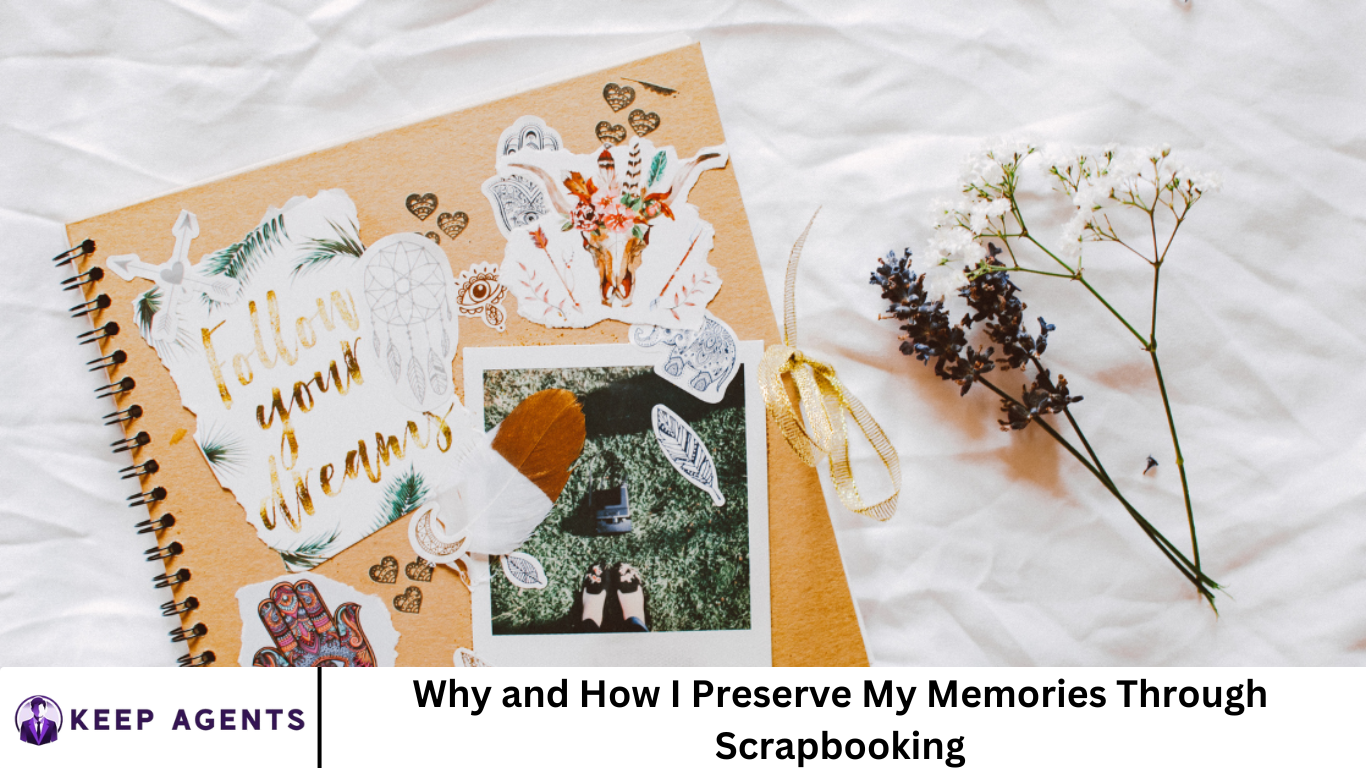World where digital photos and social media dominate how we capture and share moments, there’s something uniquely special about preserving memories through scrapbooking. For me, scrapbooking is not just a hobby:
It’s a heartfelt way to keep my memories alive, tangible, and beautifully organized. In this article, I’ll share why I choose scrapbooking to preserve my memories and the methods I use to create lasting, meaningful albums that tell my story.
Why I Preserve My Memories Through Scrapbooking
1. Creating a Tangible Connection to the Past
In today’s digital age, photos and memories often live on hard drives or cloud storage, where they can feel distant and easily forgotten. Scrapbooking offers a physical, tactile connection to the past. Holding a scrapbook in your hands, flipping through pages filled with photos, handwritten notes, and mementos, creates an emotional experience you can’t get from a screen.
The sensory aspect—touching the textured papers, seeing the colors and layouts, even smelling the ink and glue—makes memories more vivid and meaningful. This tactile connection deepens my appreciation for those moments and helps me relive them whenever I want.
2. Preserving Stories and Emotions
Photos capture moments, but scrapbooking lets me tell the stories behind them. It’s not just about images but also about the emotions, milestones, and little details that photos alone don’t reveal. I write down anecdotes, quotes, and reflections alongside pictures—like my children’s first words, funny habits, or special family traditions.
These words are like the missing voice behind a silent movie. They add context, humor, and heart to my memories, preserving the essence of those moments for generations to come.
3. Crafting a Personal Legacy
Scrapbooking is my way of creating a legacy for my family. My mother kept a notebook filled with memories about my childhood—milestones, silly quotes, favorite things—and that notebook is one of my most treasured possessions. It’s a collection of my early life wrapped in paper and ink, a legacy I cherish deeply.
By scrapbooking, I’m continuing this tradition, crafting a story that my children and grandchildren can one day hold and read, connecting them to their roots and to me.
4. A Creative and Therapeutic Outlet
Scrapbooking is not just about preserving memories; it’s also a form of creative expression. Designing each page, choosing colors, layouts, and embellishments allows me to channel my creativity and emotions. It’s therapeutic—a calming, rewarding activity that helps me process life’s events and celebrate joys.
The satisfaction of seeing a completed page or album is incredibly fulfilling, blending art and memory in a meaningful way.
How I Preserve My Memories Through Scrapbooking
1. Gathering Materials and Tools
The first step in my scrapbooking process is assembling the right materials. Some basic supplies I use include:
- Scrapbook albums (various sizes)
- Patterned and solid-colored papers
- Adhesives (glue sticks, double-sided tape, photo corners)
- Scissors and paper trimmers
- Pens and markers for journaling
- Stickers, stamps, and embellishments
- Photo prints (I usually print photos on matte paper for durability)
Starting with quality materials makes the process enjoyable and ensures my albums last for years.
2. Selecting Photos and Memorabilia
I carefully choose photos that tell a story or capture meaningful moments. Sometimes it’s a milestone like a birthday or graduation; other times it’s candid shots of everyday life. I also include memorabilia such as:
- Ticket stubs from family outings
- Birthday cards
- Drawings or crafts my children made
- Notes or letters
Including these personal items adds layers of meaning and nostalgia to the albums.
3. Journaling to Capture Stories
One of the most important parts of my scrapbooking is journaling. I write little stories, quotes, or thoughts related to the photos. For example:
- The funny thing my son said at age three
- What my daughter’s favorite ice cream flavor was that summer
- How a family trip unfolded
This journaling transforms the album from a photo collection to a narrative full of life and personality.
4. Designing the Layout
Every page is like a mini artwork. I spend time planning layouts that balance photos, text, and decorations. Some tips I follow:
- Use a consistent color scheme to unify the album
- Group photos by theme or event
- Leave space for journaling without overcrowding
- Mix photo sizes for visual interest
- Use embellishments sparingly to avoid clutter
There’s no “right” way—creativity is key, and every page is a reflection of my mood and style.
5. Creating a Routine
To keep my scrapbooking manageable, I create a routine. For example, I dedicate one evening a week or a weekend afternoon to work on my albums. Breaking the process into small, regular sessions keeps me motivated and prevents overwhelm.
I also keep a box or folder handy for collecting photos and memorabilia throughout the year, so I’m not scrambling to gather everything at once.
6. Preserving and Sharing
Once my albums are complete, I store them safely on a bookshelf, away from direct sunlight or moisture. Sometimes, I share them with family members—especially my children—letting them explore their stories in a tangible way.
I also digitize some pages by scanning or photographing them, creating backups and sharing highlights with relatives who live far away.
Tips for Beginners: How to Start Scrapbooking Your Memories
If you’re new to scrapbooking and want to start preserving your memories, here are some beginner-friendly tips:
Start Small
Don’t feel pressured to create an entire album at once. Start with a single event or theme—like a birthday party or a family vacation—and build from there.
Use What You Have
You don’t need expensive supplies to begin. Use printed photos, simple paper, and pens. Over time, you can invest in more materials as you find your style.
Focus on Stories
Even a simple photo becomes meaningful with a few words explaining why it matters. Write down your thoughts, emotions, or a funny story alongside your pictures.
Keep It Fun
Scrapbooking should be enjoyable, not stressful. Experiment, make mistakes, and enjoy the creative process.
Why Scrapbooking Still Matters in a Digital Age
You might wonder why scrapbooking remains relevant when we can store thousands of photos online. Here are a few reasons why it still matters:
- Emotional Impact: Physical albums evoke emotions and connections that digital files can’t match.
- Legacy: Scrapbooks are heirlooms that can be passed down through generations.
- Creativity: Scrapbooking blends photography, writing, and crafting—offering a unique creative outlet.
- Focus: Working on a tangible project helps slow down and truly reflect on memories, rather than quickly scrolling through digital galleries.
Frequently Asked Question
Why is scrapbooking a better way to preserve memories than just storing digital photos?
Scrapbooking creates a physical, tactile experience that connects you emotionally to your memories. Unlike digital photos stored on devices or clouds, scrapbooks combine images, stories, and keepsakes in a creative, lasting format that you can hold, share, and pass down through generations.
What types of memories are best suited for scrapbooking?
Any memory that holds meaning to you can be preserved through scrapbooking. Common themes include childhood milestones, family vacations, birthdays, holidays, weddings, everyday moments, and personal achievements. Including stories and memorabilia alongside photos adds depth and personality.
How do I start scrapbooking if I have no experience or artistic skills?
Begin simply by gathering photos and writing short stories or captions about them. Use basic supplies like paper, pens, and adhesives. There are many beginner-friendly scrapbooking kits and tutorials online to guide you step-by-step. Remember, scrapbooking is about personal expression, not perfection.
How do I organize my scrapbook to keep memories clear and easy to follow?
Organize your scrapbook chronologically, by theme (e.g., holidays, school years), or by family members. Consistent color schemes, clear titles, and thoughtful layouts help keep the story coherent. Journaling is key to linking photos with context and emotions.
Can scrapbooking be combined with digital tools?
Absolutely! Many scrapbookers print photos from their digital collections and add them to physical albums. There are also digital scrapbooking apps that let you create layouts on your computer or tablet, which can then be printed and assembled physically or shared digitally.
How much time does it typically take to create a scrapbook?
The time varies depending on how detailed you want to be. Some people work on pages gradually, dedicating an hour or two per week, while others create albums for special events all at once. The key is to make it enjoyable and manageable, rather than overwhelming.
What are some tips for preserving scrapbooks long-term?
Store scrapbooks in a cool, dry place away from direct sunlight to prevent fading. Use acid-free papers and adhesives to protect photos and pages. Consider digitizing pages by scanning them to create backups. Handling albums gently and using protective sleeves also help maintain their condition.
Conclusion
Preserving memories through scrapbooking is a deeply personal and rewarding journey. It allows me to hold onto moments, emotions, and stories in a way that feels alive and tangible. By blending photographs, journaling, and creative design, I create a legacy that connects my past with the future, and my heart with those I love. If you’ve ever considered preserving your memories more intentionally, I encourage you to try scrapbooking. It’s a gift to yourself and to the generations who will treasure the stories you share.


